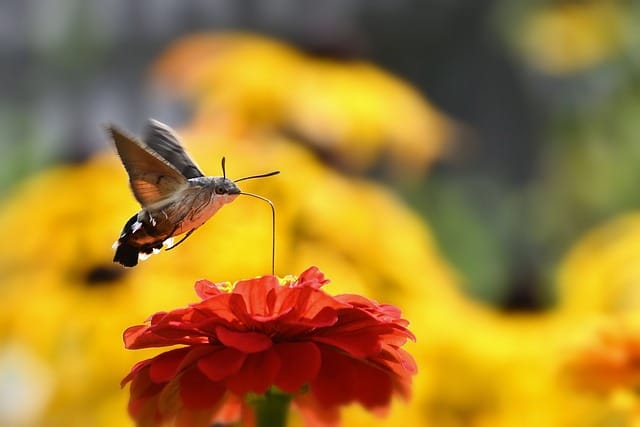Promoting pollinators: Hawk moths
These fascinating creatures play a crucial role in pollination, contributing to the survival and diversity of many plant species

In this article:
- Introduction
- Habitat and Distribution
- Morphology and Adaptations
- Life Cycle and Behavior
- Pollination and Importance as Pollinators
- Floral Preferences and Co-evolution
- Hawk Moths and Nocturnal Pollination
- Role of Hawk Moths in Plant Diversity
- Threats and Conservation Efforts
- Conclusion and Future Research
Introduction
Welcome to the world of hawk moths! These fascinating creatures play a crucial role in pollination, contributing to the survival and diversity of many plant species. In this article, we will delve into the habitat, behavior, and importance of hawk moths as pollinators.
Habitat and Distribution
Hawk moths, also known as sphinx moths or hummingbird moths, can be found in various habitats across the world. They are most commonly encountered in temperate and tropical regions where flowers are abundant. Their distribution spans from North and South America to Europe, Asia, and Africa.
Morphology and Adaptations
Hawk moths are large-bodied insects with streamlined wings and long tongues known as proboscises. Their moth-like appearance often leads to mistaken identity with hummingbirds due to their hovering flight and ability to feed while in motion. These adaptations allow them to access nectar from deep flowers. Moreover, their nocturnal vision and excellent sense of smell enable them to navigate and locate their favorite food sources in dim light.
Life Cycle and Behavior
Hawk moths undergo complete metamorphosis, consisting of four distinct stages: egg, larva (caterpillar), pupa, and adult. The caterpillars are often big, cylindrical, and have distinct patterns that aid in camouflage. They have a voracious appetite, feeding on a variety of plant leaves. Hawk moths are known for their long-distance migration capabilities, with some species traveling thousands of miles during seasonal movements.
Pollination and Importance as Pollinators
Hawk moths, while seeking nectar, inadvertently transfer pollen between flowers, facilitating cross-pollination. Due to their long tongues, they often visit flowers with long corolla tubes or those that bloom during the night when other pollinators are less active. Their role as pollinators is pivotal for many plants, including some orchids, jasmine, and moonflowers.
Floral Preferences and Co-evolution
Hawk moths have co-evolved with certain plant species, leading to fascinating adaptations. Some flowers have evolved to exclusively attract hawk moths by emitting strong fragrances at night and displaying white or pale-colored blooms that are easily visible in low light. In return, hawk moths have developed specialized mouthparts that can reach the nectar hidden deep within these flowers.
Hawk Moths and Nocturnal Pollination
Many plant species rely on hawk moths for nocturnal pollination. By being active at night, hawk moths fill the gap left by diurnal pollinators like bees and butterflies. This unique phenomenon allows plants to maximize their chances of reproduction and genetic diversity.
Role of Hawk Moths in Plant Diversity
The presence of hawk moths in an ecosystem contributes to plant diversity. Their pollination services enable plants to reproduce, and genetic variation increases. This, in turn, supports a healthy and resilient ecosystem by providing a range of habitats and resources for other organisms.
Threats and Conservation Efforts
Unfortunately, hawk moths face various threats, including habitat loss, pesticide use, and climate change. The decline in their populations could have detrimental effects on plant communities and the broader ecosystem. Conservation efforts are essential in preserving their habitats, raising awareness, and reducing the use of harmful pesticides.
Conclusion and Future Research
Hawk moths play a crucial role in pollination and contribute to the beauty and diversity of our natural world. Understanding their biology, behaviors, and interactions with plants can help us appreciate their importance and promote their conservation. Future research should focus on further unraveling the intricate relationships between hawk moths and plant species, as well as implementing effective conservation strategies to protect these remarkable pollinators.
